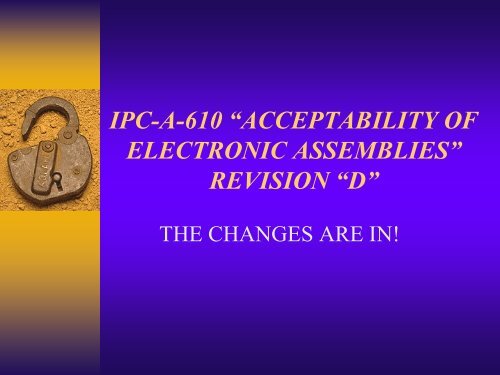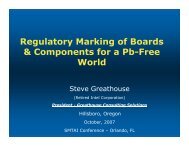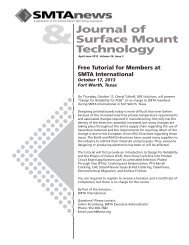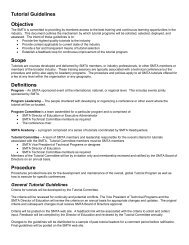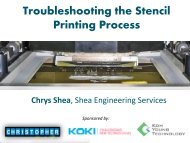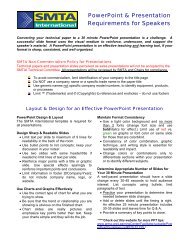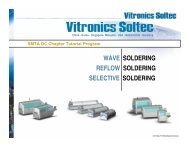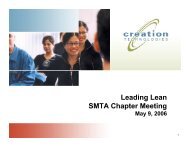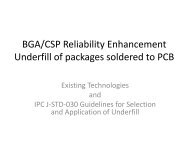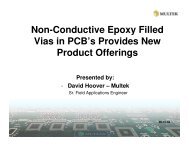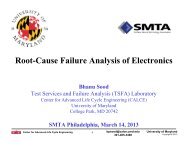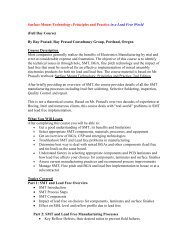ipc-a-610 âacceptability of electronic assembliesâ - SMTA
ipc-a-610 âacceptability of electronic assembliesâ - SMTA
ipc-a-610 âacceptability of electronic assembliesâ - SMTA
- No tags were found...
Create successful ePaper yourself
Turn your PDF publications into a flip-book with our unique Google optimized e-Paper software.
IPC-A-<strong>610</strong> “ACCEPTABILITY OF<br />
ELECTRONIC ASSEMBLIES”<br />
REVISION “D”<br />
THE CHANGES ARE IN!
TOPICS OF DISCUSSION:<br />
♦ USING IPC-A-<strong>610</strong> AND THE PURPOSE<br />
♦ TRAINING PROGRAM STATUS<br />
♦ NEW FORMAT<br />
♦ OVERVIEW OF EACH OF THE 12<br />
SECTIONS<br />
♦ ADDITIONAL AND NEW CRITERIA
TRAINING PROGRAM<br />
CERTIFIED IPC TRAINER (CIT)<br />
♦ Will be certified to the complete document.<br />
♦ 32 hour format has been developed.
TRAINING PROGRAM CONT.<br />
CERTIFIED IPC APPLICATION<br />
SPECIALIST<br />
♦ This course is modularized.<br />
♦ Sections 1,2,3 will be mandatory.<br />
♦ Set up is like the J-STD-001 Operator<br />
course. (If you do not do conformal coating,<br />
then why spend the time training your<br />
operators, etc.)
SECTIONS RE-NUMBER<br />
♦ Section 1 – Foreword<br />
(Same)<br />
♦ Section 2 – Applicable<br />
Documents (Same)<br />
♦ Section 3 – Protecting the<br />
Assembly (Same)<br />
♦ Section 4 – Hardware<br />
(Same – less some criteria.)<br />
♦ Section 5 – Soldering<br />
(New)<br />
♦ Section 6 – Terminals<br />
(New)<br />
♦ Section 7 – Through Hole<br />
Technology (Section 5 & 6)<br />
♦ Section 8 – Surface Mount<br />
Assemblies (Section 12)<br />
♦ Section 9 – Component<br />
Damage (New)<br />
♦ Section 10 – Printed Circuit<br />
Board Assemblies (Same &<br />
includes markings, coatings,<br />
cleaning)<br />
♦ Section 11 – Discrete Wiring<br />
(Same)
NEW FORMAT<br />
6 Terminals<br />
♦ 6.1 Terminals - Edge Clip 4.7<br />
♦ 6.2 Swaged Hardware 4.3<br />
♦ 6.2.1 Swaged Hardware - Flared Flange 4.3<br />
♦ 6.2.1.1 Swaged Hardware - Flared Flange - Controlled Split 4.3.1.1<br />
♦ 6.2.2 Swaged Hardware - Terminals 4.3.3<br />
♦ 6.2.3 Swaged Hardware - Flat Flange - Fused-in-Place 4.3.2, 6.6.6<br />
♦ 6.3 Wire/Lead Preparation, Tinning 4.3.2<br />
♦ 6.4 Terminals - Lead Forming - Stress Relief 5.3.2.3<br />
♦ 6.5 Terminals - Service Loop 5.5.4<br />
♦ 6.6 Terminals - Stress Relief Lead/Wire Bend 5.5.3<br />
♦ 6.7 Terminals – Lead/Wire Placement 5.5.5, 5.5.1<br />
♦ 6.7.1 Terminals – Lead/Wire Placement - Turrets and Straight Pins<br />
5.5.1
NEW FORMAT CONT.<br />
♦ 6.10 Terminals – Solder 6.6<br />
♦ 6.10.1 Terminals – Solder - Turrets 6.6.2<br />
♦ 6.10.2 Terminals – Solder – Bifurcated 6.6.1<br />
♦ 6.10.3 Terminals – Solder - Slotted Terminal Assembly<br />
Requirements<br />
♦ 6.10.4 Terminals – Solder - Pierced/ Perforated 6.6.4<br />
♦ 6.10.5 Terminals – Solder - Hook/Pin 6.6.3<br />
♦ 6.10.6 Terminals – Solder - Solder Cups 6.6.5
SECTION 6 – TERMINALS<br />
♦ Added illustrations from IPC/WHMA-A-<br />
620<br />
♦ Wire placement<br />
♦ Wire Insulation<br />
♦ Terminal Types<br />
♦ Soldering <strong>of</strong> wires
SECTION 6 – TERMINALS CONT.<br />
♦ Criteria for wire tinning.
SECTION 6 – TERMINALS CONT.<br />
♦ Better illustrations and more detail.
NEW SECTION<br />
♦ 5 Soldering<br />
♦ 5.1 Soldering Acceptability Requirements 6.1<br />
♦ 5.2 Soldering Anomalies<br />
♦ 5.2.1 Soldering Anomalies - Exposed Basis Metal 6.5.2<br />
♦ 5.2.2 Soldering Anomalies - Pin Holes/Blow Holes 6.5.4, 12.4.8<br />
♦ 5.2.3 Soldering Anomalies - Reflow <strong>of</strong> Solder Paste 12.4.3<br />
♦ 5.2.4 Soldering Anomalies - Nonwetting 6.5.6 , 12.4.4<br />
♦ 5.2.5 Soldering Anomalies - Dewetting 12.4.5<br />
♦ 5.2.6 Soldering Anomalies - Excess Solder<br />
♦ 5.2.6.1 Soldering Anomalies - Excess Solder- Solder Balls/Solder<br />
Fines 6.5.3.1, 12.4.10<br />
♦ 5.2.6.2 Soldering Anomalies - Excess Solder- Bridging 6.5.3.2, 12.4.9
SECTION 7<br />
♦ Criteria has changed on meniscus in hole<br />
for class 3. It is a defect, revision C it was a<br />
process indicator – reason: part<br />
manufacturers have stated that the first .050”<br />
<strong>of</strong> the lead is non-solderable.
WHAT TO EXPECT<br />
♦ TABLES LIKE J-STD-001 – These will be at the<br />
beginning <strong>of</strong> each section in Section 8 SMT.
WHAT TO EXPECT CONT.<br />
♦ Lead-free illustrations included to show<br />
visual differences.<br />
SnPb No Clean<br />
SnAgCu No Clean
WHAT TO EXPECT CONT.<br />
♦ Example <strong>of</strong> Tin-Lead and Lead-Free with<br />
use <strong>of</strong> Water Soluble Paste (Section 5)
WHAT TO EXPECT CONT.<br />
♦ Example <strong>of</strong> Tin-Lead and Lead-Free<br />
(Section 5)
WHAT TO EXPECT CONT.<br />
♦ Section 5 will show various examples <strong>of</strong><br />
connections that are Lead-Free.
WHAT TO EXPECT CONT.<br />
♦ Additional examples:
ADDITIONAL CRITERIA<br />
♦ PQFN<br />
♦ BGA<br />
♦ D-PAKS<br />
♦ Better illustrations
BGA CRITERIA Section 8.2.12<br />
♦ Defect – Class 1,2,3<br />
• Visual or x-ray evidence <strong>of</strong> solder bridging<br />
(Figure 8-144).<br />
• A “waist” in the solder connection indicating that<br />
the solder ball and the attaching solder paste did<br />
not flow together (Figure 8-145).<br />
• Incomplete wetting to the land.<br />
• BGA solder ball terminations have incomplete<br />
reflow <strong>of</strong> the solder paste (Figure 8-146).<br />
• Fractured solder connection (Figure 8-147).
BGA CRITERIA CONT.<br />
♦ 8.2.12.5 Plastic BGA – Voids (Plastic BGA’s are what<br />
were used for testing that was done by Rockwell Collins<br />
and Lockheed Martin Team providing data to the<br />
committee).<br />
♦ Thermal cycle test results show that no single value can be<br />
used for void acceptance, and some voids have no impact<br />
on integrity <strong>of</strong> the connections.<br />
♦ Manufacturers are encouraged to use test or analysis to<br />
develop acceptance criteria for voiding that consider the<br />
end-use environment. If this information is not available<br />
and x-ray is used for inspection, the following criteria<br />
apply.
BGA CRITERIA CONT.<br />
Acceptable - Class 1,2,3<br />
♦ Less than 25% voiding in the ball to board or ball<br />
to component interface.<br />
Defect - Class 1,2,3<br />
♦ More than 25% voiding in the ball to board or ball<br />
to component interface.<br />
Test data showed that more than 25% was not a<br />
problem in some cases; 25% is what the<br />
committee could live with.
PLASTIC QUAD FLAT PACK – NO<br />
LEADS (PQFN) Section 8.2.13<br />
There are some package configurations that have no<br />
toe exposed or do not have a continuous solderable<br />
surface on the exposed toe on the exterior <strong>of</strong> the<br />
package and a toe fillet will not form.
D-PAK Section 8.2.14<br />
♦ These criteria are specific to packages that employ a<br />
bottom thermal plane.<br />
♦ Criteria for non-visible thermal plane solder connections<br />
are not described in this document and will need to be<br />
established by agreement between the user and the<br />
manufacturer. The thermal transfer plane acceptance<br />
criteria are design and process related. Issues to consider<br />
include but are not limited to component manufacturer’s<br />
application notes, solder coverage, voids, solder height, etc.<br />
When soldering these types <strong>of</strong> components voiding in the<br />
thermal plane is common.
D-PAK Section 8.2.14 CONT.<br />
Target – Class 1,2,3<br />
♦ No thermal plane side overhang.<br />
♦ Thermal plane termination edges have 100%<br />
wetting.
D-PAK Section 8.2.14 CONT.<br />
Defect – Class 1,2,3<br />
♦ Side overhang <strong>of</strong> thermal plane termination is greater than<br />
25% <strong>of</strong> termination width.<br />
♦ End <strong>of</strong> thermal plane termination overhangs land.<br />
♦ End joint width <strong>of</strong> the thermal plane end termination has<br />
less than 100% wetting to land in the contact area.
SECTION 9 – COMPONENT<br />
DAMAGE (New Section)<br />
9.5 Connectors:<br />
♦ These criteria cover the plastic molded<br />
housings/shrouds which are used primarily<br />
as a guide for the mating connector.
9.5 CONNECTORS CONT.<br />
Acceptable – Class 1,2<br />
• Plastic burrs on housing but still attached (have not broken<br />
loose).<br />
• Crack in noncritical area (does not impact integrity <strong>of</strong> the<br />
housing/shroud).<br />
Acceptable – Class 3<br />
• No cracks in housing/shroud.
9.5 CONNECTORS CONT.<br />
Defect - Class 1, 2, 3<br />
♦ • Evidence <strong>of</strong> burning or charring.<br />
♦ • Changes in shape, chips, scrapes, scratches, melting or other damage<br />
that affect form, fit or function.
SECTION 10 PRINTED CIRCUIT<br />
BOARD ASSEMBLIES<br />
10.1 Gold Fingers<br />
10.2 Laminate Conditions<br />
10.3 Marking<br />
10.4 Coatings<br />
10.5 Cleanliness
IPC-A-<strong>610</strong> REVISION “D”<br />
WORKSHOP<br />
Now we will review the document!


